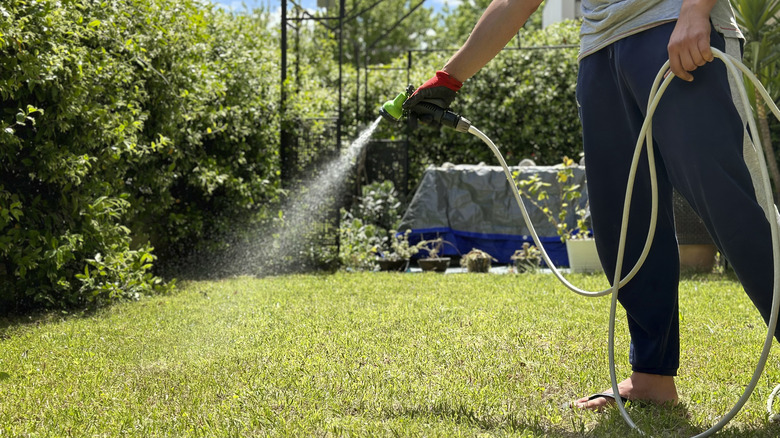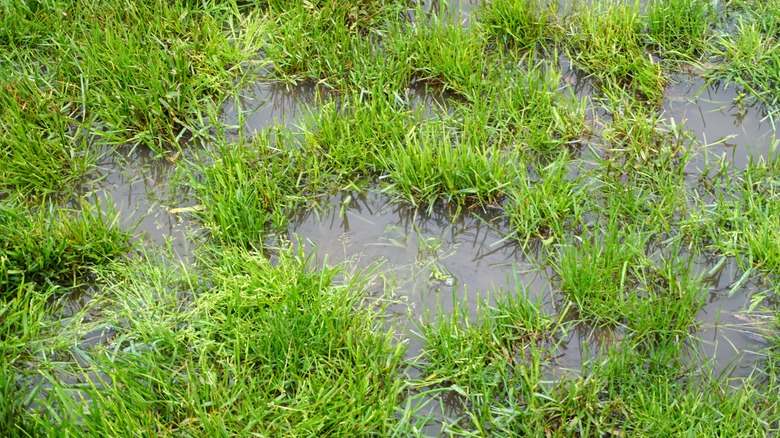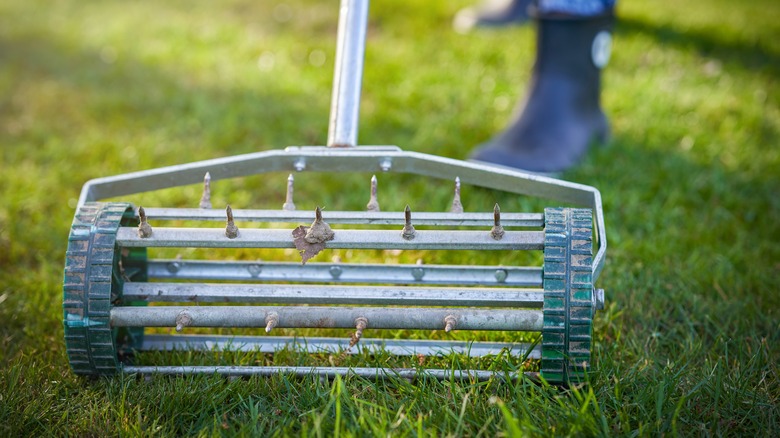The Lawn Watering Mistake That's Damaging Plant Roots & Attracting Pests
You can't quite appreciate the amount of work that a healthy lawn requires until it's your responsibility. Even something as simple as watering your lawn at the best time is surprisingly easy to mess up. If you consistently overwater your lawn, you could invite pests and damage its root system, which can lead to more turf problems in the future.
Overwatering is, contrary to popular belief, an even bigger problem than underwatering — in the sense that it's a much more common mistake and also has more potential risks. Grass is better equipped to withstand a bit of drought than to be flooded with more water than it can absorb. And since grass needs less water than you may think, it's easy to accidentally overwater.
Signs of overwatering include shallow roots, spongy-feeling grass, thin or bare patches, excessive weed growth, fungal infections, discoloration, and lots of bugs. If your grass gets drought stress in the summer, that could be a sign that it was overwatered previously as well. Here's why overwatering attracts pests and damages grass roots, and what you can do to fix it.
How overwatering creates issues
Overwatering floods the lawn with more water than the grass roots can absorb, causing the excess to sit in the soil or run off onto your driveway or the street. Over time, the extra water replaces pockets of air in the soil, which deprives the roots of oxygen. This forces the roots to stay closer to the surface in order to get enough air to survive. A lawn with shallow roots is weaker and more vulnerable to drought. In addition, overwatering promotes overgrowth of the thatch layer, which consists of decomposing plant material mixed with live grass and roots. Thatch buildup can further suffocate the root system and cause damage.
Overwatering also creates a moist environment for insects to thrive in, including mosquitoes, fire ants, pill bugs, and snails. Moisture attracts grubs that feed on roots as well as other insects that use your lawn as a meal, such as spittlebugs, mole crickets, and springtails. Waterlogging, root rot, and thatch build-up further encourage insects, and they're better able to escape insecticides in these layers of the lawn.
The specific pests that you see partially depends on where you live. But these bugs are often more than just a nuisance — they can cause lawn damage themselves by eating the roots of your grass. They may also attract predators like mammals and birds, which may harm the grass further by digging it up to feed on bugs.
How to fix an overwatered lawn
If you've been overwatering your lawn, it's not too late to undo the damage (bugs included). The first step is to stop watering and let the grass fully dry out. You can aerate the lawn by poking holes in the soil, helping oxygen and nutrients reach the roots. It's also important to address thatch build-up — a rake can help break it up, or you can buy a dethatching product.
In general, it's best to water less frequently and more deeply. When in doubt, err on the dry side. Rather than going by an automated system, let the lawn fully dry out before you water again. Your grass will start telling you it needs water when you see slight wilting and the grass shows footprints. Lawns typically need only about an inch of water per week, including rainfall. Water one to three times per week as needed, aiming for about ⅓ to ½ of an inch of water per session. The best time of day to water your lawn is in the early morning so it can dry out by the end of the day.
As you heal your overwatered lawn, you may notice other problems — like pests — going away on their own. However, you may also need to treat these issues separately. For example, you can use a natural or store-bought insecticide for pests that you still observe causing damage, like lawn grub control or Dawn dish soap for fire ants.


